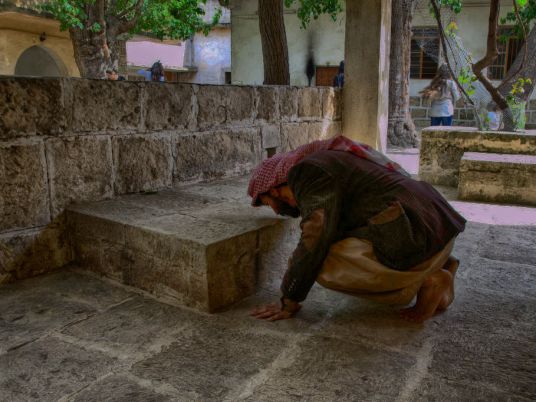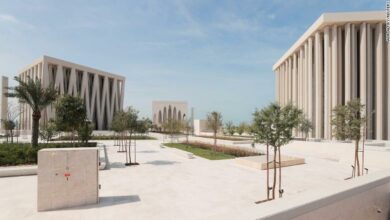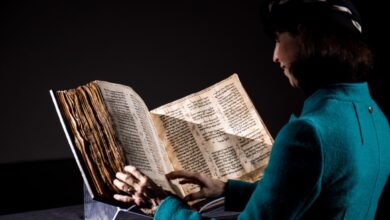
The sun is beating down on us. The ruins are shining through the gaps in the bushes on the hillside. Finally, we turn onto the concrete road leading to Lalish. A barrier across the road prevents vehicles going any further.
A sweating Peshmerga with a machine gun asks us what we are looking for. We tell him. He nods with his head then tells us to park our car and take off our shoes. Nobody can enter Lalish, the most sacred city of the Yazidis, with their shoes on.
We are going up the mountain barefoot. The concrete is burning our feet. Children are staring out curiously from the hundred-year-old houses carved into the hills on either side of the road. The starlings are circling around the houses, their voices filling the air.
"Welcome to Lalish," says a tall man in a white turban standing under a dome, motioning for us to follow him. His name is Baba Chawish. He is one of the Yazidi monks living in the city. Before stepping under the dome, he makes some gestures towards the sun, then takes his leave. A narrow corridor leads to the internal halls of the sacred city.
Holy water that purifies all
The city of Lalish is at least 900 years old. Located in the foothills of the Arafat, M’zgat and H’zarat mountains, in Kurdish northern Iraq, it is the final resting place of the Lebanese Sufi Sheikh Adi. He passed away here nine centuries ago after uniting the Yazidis present on this area and implementing the caste system. He did accomplished these things exactly where the city now stands.
The city of Lalish has destroyed twice — first in the 13th century and a second time in the 15th cen-tury — but it was always rebuilt. There is 600 years between the oldest and newest buildings, but they are very compatible.
A spring from the mountains runs through the city, feeding a pool in the center. According to the Yazidi faith, if someone washes their face three times in this sacred water and calls to the Light-bringer Angel, they become a member of this sect of 600,000 believers. They will not enter into the leading caste of Sheiks, of course, but become one of the more humble Murid.
This baptism-pool also has a new function: the Yazidi women, children and men who escape the clutches of the “Islamic State” terrorist orgaization make their pilgrimages here.
Baba Sheikh, the highest religious leader of the Yazidis made a religious declaration one year ago concerning the sacred water. He declared that it has the power to purify anything — from forced conversions to Islam, to gang rape. Any kind of outrage can be washed away by the holy water, he said.
The water can also have a transformative effect on the unborn babies of women who have been impregnated under violent circumstances, such as while held in captivity. Such babies can be turned into true Yazidis by the holy water. Many such babies have been born recently.
Although the Islamic State is loosing territory in the ongoing war, they continue to control Mosul, the largest city of the region. According to the religious leader's calculations, there are still about 3,000 Yazidis — men, women and children — held hostage by the terrorist organization.
They are bought and sold like animals on the markets of the occupied cities. The self-proclaimed caliph — who rules the so-called caliphate founded by Islamic State — has a particular aversion to Yazidis. In dozens of fatwas, he has condemned them all to death.
But the Islamic State is not the only organization aiming to eradicate this religious sect, which once had millions of followers. The Ottoman Empire did its best to destroy the sect, assimilating them into Islam. Both Iran and Syria have attempted the same thing.
Truth be told, none of the major monotheistic religions look kindly on the Yazidi people, who have a unique faith.
‘We worship the Light-bringer Angel’
We are too late to share in their New Year's celebrations, which take place in April. But we are invited to eat boiled eggs, which symbolize the sun, giver of power.
Our guide continues his brief account of the Yazidi religious doctrine — and it soon becomes clear to me why the major monotheistic religions can't stand these people.
According to their belief system, after creating the world, God left it entirely alone. Lucifer, the most beautiful and powerful angel, manifested in the world, providing a kind of bridge between God and the human race.
The Yazidis call this archangel Melek Taus, and his church stands in Lalish. But he is identical with the Satan of the Bible, the Torah and the Quran — except that Yazidis don't see him as the originator of sins and in conflict with God.
Yazidism is one of the oldest monotheistic religions. It contains the concepts of heaven and hell, but one’s final destiny is determined by one’s own soul.
Meanwhile, they also believe in the transmigration of souls — or reincarnation — with members of the leading caste sometimes being reborn for centuries in order to help their followers. The highest religious leader, Baba Sheikh, for example, is none other than the reincarnation of the sect’s founder, the above-mentioned Sheikh Adi.
The sheikh arrives
Our theological training ends when Baba Sheikh enters the courtyard where we are sitting. Sheikh Adi's incarnation arrives with a walking cane, having the appearance of a man in his mid-sixties. The Yazidis kiss his hand, but when my turn comes he shakes my hand. I am introduced, and he looks me up and down anxiously, then nods. Baba Chawish tells us to follow the sheikhs, because the lunch is almost ready.
We arrive in a big hall, taking our seats in chairs propped against the walls. Baba Sheikh greets me and asks me not to take photos without permission, and not unaccompanied. More men enter the room, holding large tables, and set them up, spreading a table cloth. Food is brought in, and all 20 of us begin to eat our lunch, standing up at the table in silence.
As a foreign journalist, the Yazidis admit me with pleasure. But at the same time, they fear me as a stranger.
After centuries of persecution, the Yazidis remain isolated, mostly lacking external points of reference, their belief system disconnected from the outside world. Their traditions are passed down by word of mouth, and there is no collection of written holy texts.
These people have never conducted any sort of violent campaign of proselytizing . Throughout the history of their religion, they have always been completely isolated from the non-Yazidis. Even now, if a Yazidi marries outside of the faith, it causes a serious rupture in the community.
In 2014, in the Sinjar mountain area and neighboring areas, the Islamic State group conducted a systematic campaign of genocide against the Yazidis. Thousands were killed and hundreds were captured or expelled from their homes.
The archangel-worshipers suddenly attracted worldwide attention. However, very little was known about them, with most information provided by the diaspora in the West, mainly in Germany.
Then, realizing that they were in the global spotlight, the sheikhs decided to deal with the common misperception concerning their religion, namely that they worship Satan. It is an idea largely backed by the early Orientalists, and an idea that the sheikhs are keen to dispel.
The Yazidis speak Comanche, a Kurdish dialect, and the urban Kurds consider them to be Kurdish people. However, the Yazidis have always has drawn a sharp line between themselves and the majority Sunni Muslim Kurds around them. In the hope of breaking down barriers, dozens of Yazidi cultural centers have been established in recent years to introduce the religion to the general Kurdish population.
Adam's family line
With heavy stomachs after lunch, our group embarks on the obligatory protocol of photographs.
While nobody is paying attention to me, I take the opportunity to head towards the sanctuary. I make my way first to the kitchen first, where the girls allow me to take photos of them, and then they show me the sanctuary.
There is a dim light inside, the walls amplifying the sound of the rippling brook. A Yazidi woman kisses a stone in front of me, but instead of chasing me out from the temple, she is smiles when she sees me. They only yell at me when I want to step on the stone on my way out. This is forbidden, according to their traditions.
The main entrance is an ornately carved door, with a black snake squirming on its right side. They kiss it when entering the sanctuary. According to the traditions, the black snake stopped a leak on Noah's Ark, using its body. And for this reason, the snake is considered a sacred animal.
Yazidis view themselves as the direct descendents of Adam, the original human being. According to the traditional Biblical account of Adam and Eve, humans and snakes have a less sympathetic relationship.
I leave the temple and head toward the mountain, where I find the baptism pool, with several young girls sitting next to it on the stairs. They smile when they see me, and let me take photos, as do two older women.
I learn that the logs in front of the pool are also sacred. If a newborn baby can't sleep, the mother brings it here. She bites off a piece of the wood and puts it into the baby's cradle. The locals swear that this method is effective.
I watch child being baptized in the water, a ritual that cannot be photographed, I am told. A newborn child's face is being washed with water, transformed into a Yazidi by the will of the mother's family.
After my star-gazing trip, I sneak back to the sheikhs, who are already looking for me. They assign me an escort, who shows me around for the second time and explains the symbolic meaning of everything as we go.




